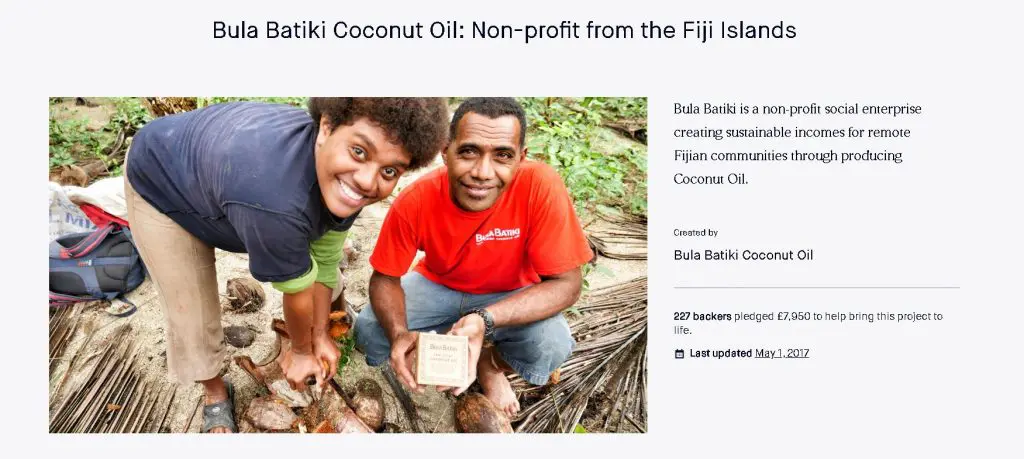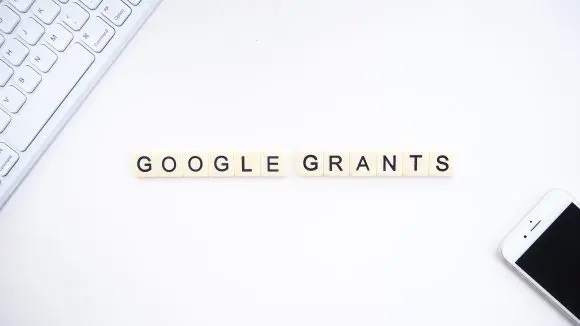
Key discussion topics:
- The grant application process
- Researching grants
- Applying for grants
- Further stages of the grant application
- How to write a proposal
- Crowdfunding
Funding is one of the most common struggles for our partners in Fiji. Reading through the organisation’s pages you must have noticed the number of times funding cropped up as major challenge among our partners.
Researching and applying for funding is a lengthy process, and as many of our partners are short staffed it is clear why they don’t have time to do it themselves. Therefore it is incredible to have this opportunity to link you with these businesses to suggest solutions for this common problem.
The specifics of funding related action projects differ quite widely between our Fijian Partners. Many have requested standard funding proposal documents which might be a template they could adapt for different funding opportunities while others are interested in receiving suggestions to improve their overall funding strategies.
In this section of the skills series, we will look into the grant application process to give you a holistic understanding of the whole process (even if your organisation doesn’t expect you to be involved in the active application process) as well as other funding opportunities you could explore on behalf of your organisation.
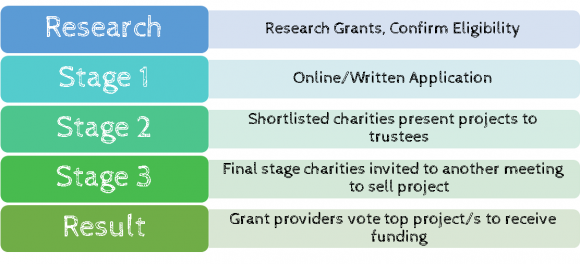
So here is a simplified overview of the stages generally involved in a grant application. Obviously these will differ between different funding bodies but this gives you an idea of what to expect…
Researching grants can be a laborious process, so you can expect to invest a large amount of your time in this stage!
And remember to read the grant terms and conditions thoroughly before applying as sometimes there are small catches that might make your organisation ineligible.
Where to search…
Here are a few places for you to start searching for grants…
- The Directory of Grant Making Trusts 2020/21 – an extensive book containing thousands of grants (check your online uni library!)
- Beehive – grant suitability checking tool (free)
- The Big Give – match funding campaigns specialist (free)
- Grants Online – aid for grant research (some free content)
- GrantNAV – advanced search engine for grants (free)
- FundsforNGOs – online resources for NGO funding (subscribe free)
- Grant Select – database of funding opportunities (free trial available)
- Funding Central – database of funding opportunities
- This PDF also includes the names of large family foundations and grant-making trusts.
- And don’t forget your best pal Google!
A useful resource for a partner could be a list of grants/ funding opportunities you believe they might be eligible for. By investing time into finding these opportunities on your partner’s behalf you are saving them vital hours of time they must conserve for their daily business operations.

- Most grants are available to target a specific project within an organisation rather than the general running costs. So, check your organisation has a specific project they require funding for, and if they don’t it could be worth suggesting one in your proposal!
- Check application deadlines, make a chronological list and submit applications in advance (Leave room for error, if an application is incomplete and has to be sent back to your organisation to be amended it may not be viewed until the next board meeting!)
Once you have found some grants that meet your organisation’s criteria its time to get writing!
Some trusts have online application forms with questions, whereas others can be more ambiguous, asking you to summarise in a short letter why your organisation deserves a grant. However, in order to complete an application, your organisation generally will need to include:
- Project description
- Why
- How (strategy)
- Where
- Who
- Project Goals (and how to measure success)
- Project Future
- Project Budget
- Business details
You can understand when looking at the common information required above why it is so important to have a specific project/s in mind when applying for grants.
Here is an example of what a grant application looks like for The Lions Club International…
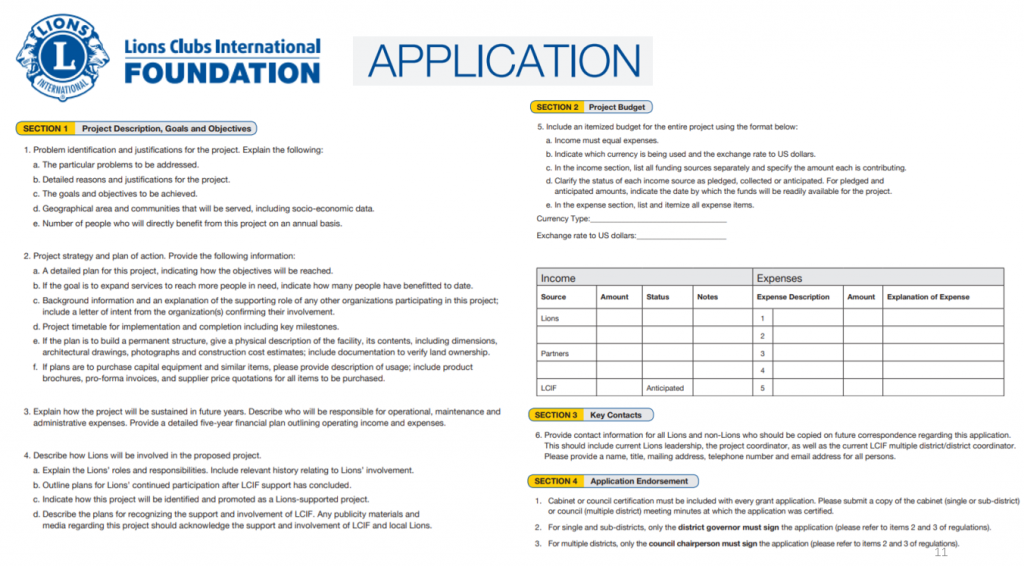

Tips on how to write a grant application:
- Tailor your application for each grant provider
- Support your application with quantitative evidence
- Use case studies to highlight previous successes
- Use bullet points for key information
- Check your application using Grammarly
For more advice on Fundraising, applications check out the directory of social change.
Create timelines for all grants you are suggesting applying for to ensure your partner organisation has availability on dates where presentations/meetings might take place (and to make sure no important deadlines are missed!)
It could be worth creating an overall calendar to compile the deadlines for all the grants you think your partner may wish to apply for.


As a virtual intern, it is unlikely your will be involved in the application process at all, let alone stages 2 & 3, which involve presenting and interacting directly with the grant providers trustees.
However, it would be beneficial to provide your Fijian organisation with resources so they can prepare for these stages. This could involve a template for a project pitch, a timeline of the application process, key points to cover or even just professional presentation pointers!
Make sure they have all the information you’ve gathered during your project so they are ready to sell their project and successfully secure that funding.
Here is a blog showcasing the work of our Charity Fundraising intern from last summer. Hopefully, looking over her work might give you a better idea of the sorts of funding documents you could produce that would add value to your organisation.
Lots of our partners have requested standard project proposals to be created to support their future funding applications. This section goes into how to write a proposal in detail…

- Acquire “buy-in” from stakeholders, investors and project workers
- Ensure that everyone is working towards the same goals and priorities.
- Allow budget and staff changes along the way – things do go wrong, so it is easier to change a plan once you have an original plan and remain in control during the process!
-
It establishes project viability
Clear proposals prove the viability of a project or program.
- Clarifies expectations
It increases clarity regarding requirements and how they will be achieved.
- Creates structure
If the structure and organisation is established at the beginning of the project, then everyone knows who they are responsible to and for.
- Increased budget
Successful proposals can lead to future approved budgets and financial support for organisational growth and project replication from stakeholders and investors involved in the project.
- Business growth
Proposals can help grow the budget of an organisation with the involvement of more stakeholders and investors.
- Expands the brand
The involvement of stakeholders can forge new alliances and increase a brand’s credibility and exposure.
- Ensures future success
If methods and measurement tools are planned in advance, then the project is far more likely to be successful in achieving its aims and objectives.
- Establishes How to Plan for Success
Proposals are useful planning documents and templates for the implementation of future projects.
1. Formally Solicited
A formally solicited project proposal is established in response to an official request for a new proposal.
2. Informally Solicited
An informally solicited proposal has no specific document required to outline customer or audience demands.
3. Unsolicited
Unsolicited project proposals can be compared to a cold call, an “aha” moment or an unexpected but enlightening conversation with a customer or member of staff — no one asked for or expected to receive one, but if the audience can relate to the proposal, it can prove extremely valuable.
4. Continuation
Continuation project proposals are usually updated or reminder for ongoing and already approved projects.
5. Renewal
A renewal project proposal is required when an ongoing project has been terminated or the resources and support behind such a project can no longer be used.
6. Supplemental
A supplemental project proposal is required when more resources are required to complete a project than were originally proposed.
Remember! A project proposal is not ...
… a Business Proposal (a document in which legal terms are outlined and signed as a contract). Clients and sponsors sign off the contents of a project proposal but it is not a legally binding contract.
A basic project plan should include the following elements:
- Project aims: what are the overall aims and objectives?
- Project deliverables: what are the specific, tangible aims to achieve the overall aims?
- Project schedules: what specific tasks need to be completed? How much time will they take to complete, who will be responsible for them, what key interdependencies are there between specific tasks and what key deadlines need to be met?
- Resource requirements: what time, equipment, budget and people are needed to deliver project deliverables according to schedule?
- Communication plan: who needs to be kept informed about project progress and how?
- Risk management: identification, monitoring and mitigation of risks?
- Quality guidelines: detailed and measurable guidelines for the level of output quality desired according to budget, time and resources available

You could use a Gantt chart to help you:
- Establish the initial project schedule
- Allocate resources
- Monitor and report progress
- Control and communicate the schedule
- Display milestones
- Identify and report problems
You can watch a tutorial on how to design your own Gantt chart here.

Before you start writing, think about the following:
- Define your audience.
- Determine the problem being solved by your proposal.
- Conduct research on the current state of the issue and potential solutions.
- Proactively determine the effect that this project will have on company success.
- Establish a timeline and determine the type and amount of resources required.
- Begin to outline your proposal document.
When you are ready to start writing, you could follow the following structure:
Section 1: Project Information
- Name of the Organization
- Project Title
- Project Summary
- Project Timeframe
- Prepared By
- Attached Documentation
- Project Contacts (any individuals involved in the project)
Section 2: Project Summary
- Why are you doing this project?
- What will you be doing?
- How will you be doing it?
- Who will be doing it?
- Where will it be done?
- How long will it take?
- How much will it cost?
- Project Background: what is the current state of the problem you are trying to solve? Why should your target audience care about solving it? Try to keep this to 1 page.
- What are the aims and objectives of the project?
Section 3: Project Methodology
The project methodology section of a proposal is where you detail the plan for how the objectives mentioned in the previous section will be achieved. This is the first section of the proposal that details the course of action to remedy the problem and is meant to prove that adequate research has been done for this decision. To start, outline the methodology being used, the population being addressed, and establish the process for reaching your objectives.
This section is typically broken into three parts:
- The Project Approach Summary: Who will be team delivering the project? What tools will be used? How will changes be addressed during the implementation of the project?
- Project schedule: What tasks need completing? How long will they take to complete? Who will complete each task? What resources will be needed for each task? What key deadlines need to be met? Use a Gantt chart to help you map this out.
- Project Deliverables: what tangible results need to be achieved? (e.g. product, information)
Section 4: Project Risk Management
- Risk Management Plan: how will risks be minimised during the project?
- Risk Register: What potential risks are there? How will they be mitigated?
Section 5: Project Costs
- Project Budget: budget breakdown in different categories.
- Budget Narrative: budget breakdown if anything needs clarification.
- Additional Financial Statements: e.g. profit and loss statement, a tax return, or funding sources, if necessary.
Section 6: Conclusion
Review of most important points in the proposal.
Section 7: Appendix
Additional charts, graphs, images, or reports cited in the proposal.

Overall, a good project proposal should allow you to do any of the following:
- Define the reason why a project is necessary
- Detail project requirements, specifying the quality of the deliverables, estimating resources and timescales
- Prepare a business case to justify the investment
- Secure corporate agreement and funding
- Develop and implement a management plan for the project
- Lead and motivate the project delivery team
- Manage the risks, issues and changes on the project
- Monitor progress against plan
- Manage the project budget
- Maintain communications with stakeholders and the project organisation
Check out this snip-it from our alumni series interview with TP Alumni, Alex Wallace aka ‘Pasky’.
Listen to Alex, the Founder of The Mintridge Foundation (a charity dedicated to enhancing life skills in young people through sport) and Winner of ‘Sportswomen of the Year 2018, The Sunday Times, Grassroots Award ‘ gives some expert tips on how to tackle funding bids.
Crowdfunding is a great way to raise money through the collective efforts of a lot of people. By utilising large networks individuals, businesses and charities can ask for small individual investments from contributors, then collectively these donations are sufficient to help fund business costs or projects.
Crowdfunding has become increasingly popular and easy to carry out as social media and peoples online social networks have expanded. A strong crowdfunding campaign has the potential to go absolutely viral and raise far more money than could ever be obtained through grant applications!
Although you wouldn’t necessarily be expected to actually run a crowdfunding campaign on behalf of a partner, it could be a really valuable element to include in a funding strategy. By creating a crowdfunding proposal with all the key information they would require to run a crowdfunding campaign you may be exposing them up to an exciting new funding opportunity.
Maybe they’ve already tried crowdfunding or have it on their agenda of areas to explore…it’s definitely an option which is worthy of exploration anyway!
For example, take Captain Tom Moore’s 100th birthday walk for the NHS in the UK… His crowdfunding campaign on Just Giving attracted over a million supporters and raised over £32 million for the NHS – incredible!
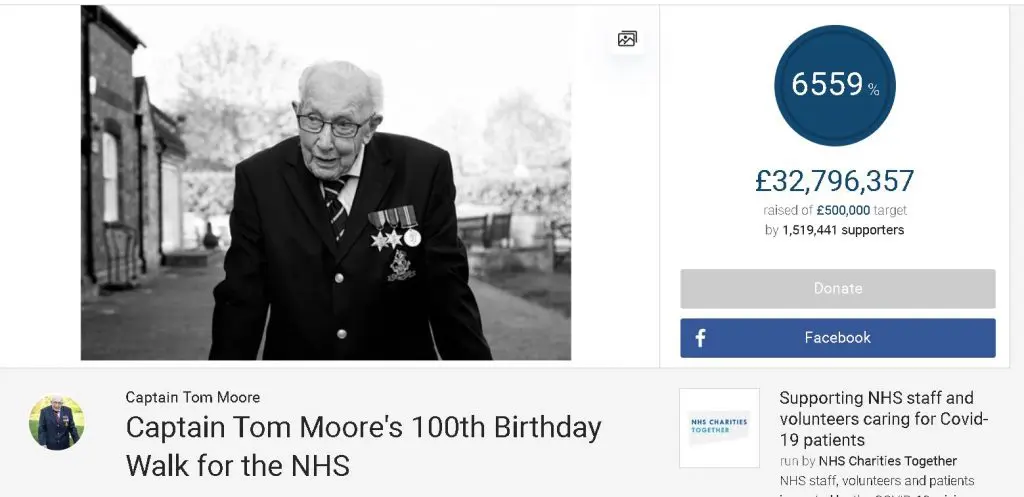
It is important to understand the potential, as well as limitations crowdfunding, may have for your organisation to help you make an informed decision as to whether it would be a suitable fundraising avenue to explore.
- Relatively low financial risk involved
- The campaign could go viral
- You can utilise and/or create a strong community
- Could attract media attention which is good for marketing
- Good alternative finance option if more traditional methods have failed
- Investors could become loyal customers
- Some financial and time investments
- Doesn’t work for all businesses
- Have to pay online fees for certain sites
- Your idea could be copied (If concerned you could get a patent beforehand)
- Not reaching your funding target could damage your business image
Assess your organisation’s needs
Take a bit of time to think about how your organisations funding goals could be met with a crowdfunding campaign. It is also worth considering the following questions to get a better idea of whether it is a worthwhile exploration for your particular organisation…
- Does your partner have a unique story that people would be interested in supporting?
- Do you need the money quickly or is it a long term solution?
- Will your organisation be contributing to their community in a different way than before?
- Does your cause tie-in with a current news topic, holiday, crisis, or event?
Select a platform
StartSomeGood is a crowdfunding platform designed specially for social enterprises, non-profits, and community projects. So far it has helped over 1000 amazing ventures to raise more than AUD 15 million. StartSomeGood is proud to have the highest project success rate in cause crowdfunding at 53% and as a smaller crowdfunding platform they are more focuses on delivering high quality support to every project on the site to help them succeed.
GlobalGiving is another, larger crowdfunding community for non-profits and they also have some useful resources available for download including how to run a successful campaign.
Other more well-known platforms include Just Giving, Go Fund Me, KickStarter and CrowdRise.
Personalise your campaign with your brand
Highlighting your brand image through the use of your logo, colour scheme, font and brand persona will help people understand who they are supporting. It will also help your campaign look professional – having uniformity across online platforms is key!
Tell a captivating and unique story
Use your crowdfunding platform to the max by engaging your visitors through a compelling story. Remember you only have a few seconds to captivate readers so keep it short and to the point. You can add extra value by using photos, testimonials and videos to show the impact your partner organisation has had so far through their work. Videos are particularly effective in dramatically increasing the success of crowdfunding campaigns.
Offer a variety of giving levels
Don’t turn away small sums of money as these often form the bulk of donations in many campaigns. However, it is worth emphasising how different donation amounts could help your organisations project – this might persuade people to donate more if they can understand the direct impact their money will be having. You could take this to the next level by suggesting offering a gift in exchange for donating more. Maybe your partner organisation has old stock they haven’t sold which could be utilised in this way!
Design a communications strategy
Having a well-designed campaign set up is only half the story – make sure you prepare your partner organisation with suggestions on how to reach their audience so that they get donations!
At the very least all donors should get an immediate thank you email which should feature a ‘’share your support for our cause on social media’’ section. Getting donors to share on social media is a great way to promote your campaign as your are able to utilise their social networks too.
Other areas you could explore include suggesting partners who can increase engagement on your organisation’s behalf, designing physical flyers that could be distributed around a local community, creating a social media plan or even bringing in a local celebrity!
Check out the PDF below to find out more about tips and tricks for crowdfunding success!
This is a detailed crowdfunding guidebook sponsored by Just Giving and The Institute of Fundraising.
Check out our very own Fijian Partner, Bula Batiki’s crowdfunding success on Kickstarter!
This campaign is an excellent example of how crowdfunding could be valuable to your partner organisation in Fiji. Callum and Ellis were able to exceed their fundraising goal, collecting £7950 in donations (their goal was £5000) to support the creation of their non-profit social enterprise which creates sustainable incomes for remote Fijian communities through producing Coconut Oil.
Additionally, the content on the page is an excellent example of how to design and what to include on a crowdfunding page – it tells a unique story, has high-quality images and video to support this and is an excellent example of how an enterprise can gift supporters who donate different amounts.
